Top 12 Electric Cars Coming in 2024
Even though vehicles with an internal combustion engine are still more common on the road than electric ones, you can be sure it is temporary. The new electric cars entering the market in 2024 promise us all a better future in terms of a significantly reduced environmental impact.
We have prepared a list of noteworthy 2024 electric vehicles. So you can already make a wish to Santa Claus or pre-order a car online.
No matter which electric vehicle you pick from our list, we promise it’s compatible with all the smart go-e Chargers.
Note:
Electric car manufacturers often keep upcoming vehicle details under wraps to create anticipation. But rest assured, we will be regularly updating information about the most significant electric vehicles of 2024.
1. Audi A6 e-tron Avant
The upcoming Audi A6 e-tron Avant looks classy. The vehicle comes equipped with an advanced electric platform capable of delivering 270 kW of charging power at a HPC charging point, thanks to 800-volt technology. Audi claims that this high-performance variant will accelerate from 0 to 100 km/h in under four seconds. To give you a picture, here are some of the fastest accelerating electric cars: The Tesla Model S accelerates from 0 to 100 km/h in 2.1 sec, Porsche Taycan in 3.2 sec and the… Audi e-tron GT - 3.2 sec!
It takes less than 25 minutes to charge the battery of the Audi A6 e-tron Avant from 5 to 80%. Its e-predecessor, Audi e-tron GT, was able to charge this amount in 22.5 minutes.
At the rear, a continuous OLED light strip creates dynamic lighting effects. Flank lighting units serve dual purposes, projecting warning signals and indicators onto the asphalt. The LED matrix spotlights possess the capability to project video game content onto walls, ensuring a cinema-quality experience. Not something you would normally expect from a car, but why not? If you are a fan of the German brand, expect the Avant model in 2024.
- Range: Up to 700 km
- Top speed: No information available
- Max DC charging power: 270 kW
- Max AC charging power: No information available
- Acceleration (from 0 to 100 km/h in sec): < 4 s
- Battery capacity: 100 kWh
- Consumption (kWh/100 km): No information available
- Estimated price: €53,000 - 57,000
![[Translate to Englisch:] Audi A6 e-tron Avant](/fileadmin/_processed_/3/d/csm_audi-a6-e-tron-avant_c46589fbd1.jpg)
2. Polestar 3
The SUV Polestar 3 will initially feature dual-motor power, with rear-wheel drive to come later. It houses a 111 kWh battery for a WLTP range of 610 kilometres. With a hefty weight of over 2.5 tons and a length of 4.90 metres, it achieves a swift 0-100 km/h time of 4,7 seconds. Standout features include Brembo brakes, a heat pump, adaptive two-chamber air suspension and bidirectional charging.
-
Range: Up to 610 km
-
Top speed: 210 km/h
-
Max DC charging power: 250 kW
-
Max AC charging power: 11 kW
-
Acceleration (from 0 to 100 km/h in sec): 4,7 s
-
Battery capacity: 111 kW
-
Consumption (kWh/100 km): No information available
-
Estimated price: From € 89.900
![[Translate to Englisch:] Polestar 3](/fileadmin/_processed_/b/f/csm_polestar-3-ev_eee6763199.jpg)
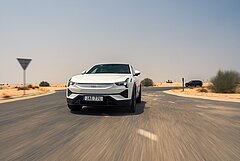
3. Volvo EX90
While car manufacturers such as Tesla are fully dedicated to producing electric vehicles, others, such as Volvo, are tiptoeing into the electric future by gradually including more and more electric cars in their product range.
Volvo, the Swedish-Chinese car manufacturer, has made a promise to sell electric vehicles only starting from 2030. So far, at least one new purely electric car has been launched every year since 2021. The Volvo EX90 with 7 seats can bring you as far as 600 km on a single battery charge and comes with bidirectional charging capabilities.
The vehicle, with an elegant Swedish design and impressive off-road ability, comes with a 111 kW battery and can be charged from 10 to 80% in around 30 minutes at a fast charging station. But what if you want to charge in the comfort of your home? You can easily charge the Volvo EX90 with the go-e Charger Gemini or Gemini flex 11 kW. The charging speed will be slower, but if you're doing it at night, this won't make a difference.
-
Range: Up to 600 km
-
Top speed: 180 km/h
-
Max DC charging power: 250 kW
-
Max AC charging power: 11 kW
-
Acceleration (from 0 to 100 km/h in sec): 4,9 s
-
Battery capacity: 111 kWh
-
Consumption (kWh/100 km): 21,1 kWh/100 km
-
Estimated price: From € 93.460

go-e Charger Gemini flex 11 kW
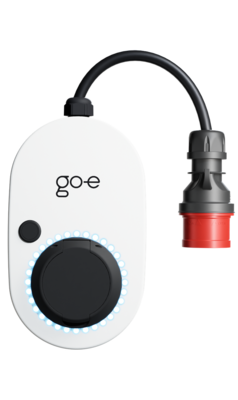
The intelligent wallbox can be used both stationary in the wall bracket and mobile. No electrician is required for the installation of the charging station. Charging power from 1.4 kW to 11 kW. 1-phase or 3-phase charging.
go-e Charger Gemini flex 22 kW

The intelligent wallbox can be used both stationary in the wall bracket and mobile. No electrician is required for the installation of the charging station. Charging power from 1.4 kW to 22 kW. 1-phase or 3-phase charging.
go-e Controller
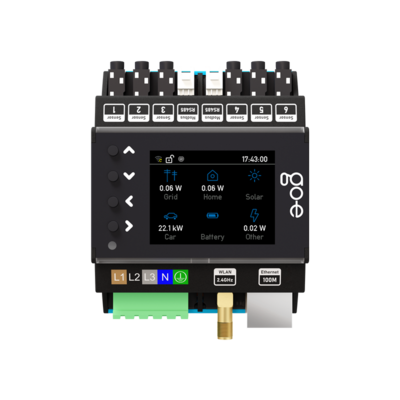
The go-e controller enables you to improve self-consumption from your PV system and ensures with dynamic load balancing that your house connection is not overloaded.
go-e Charger Gemini 11 kW
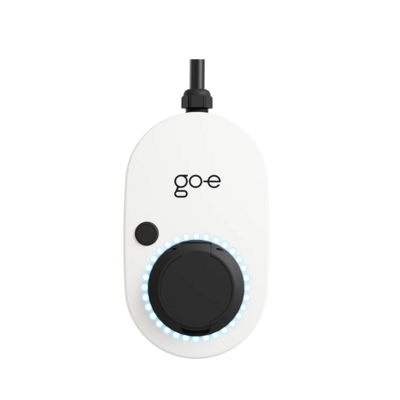
The compact wallbox for stationary use, at home or at the workplace. Simple installation, intuitive operation and smart comfort functions. Charging power from 1.4 kW to 11 kW. 1-phase or 3-phase charging.
go-e Charger Gemini 22 kW
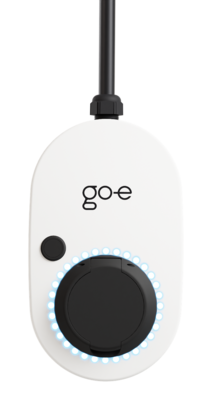
The compact wallbox for stationary use, at home or at the workplace. Simple installation, intuitive operation and smart comfort functions. Charging power from 1.4 kW to 22 kW. 1-phase or 3-phase charging.
4. Tesla Cybertruck
We've been hearing about this one for a long time, haven’t we? Well, it’s finally coming. Featuring six comfy seats and extra storage beneath the second row, the Cybertruck comes with maximum payload of 1,134 kg and 1,897 litres of lockable storage. Whether you have your favourite playlist or enjoy listening to what's playing on the radio, you'll probably like the sound flowing from the 15 dynamics, two of which are dedicated subwoofers and distributed amplifiers.
What makes it truly special is that the Cybertruck is bulletproof and comes with armour glass that can resist the impact of a baseball bat at 112 km/h. Its robust powertrain and low centre of gravity ensure exceptional traction and torque control, facilitating 0-100 km/h acceleration in a mere 2,7 seconds and up to 547 km of range. The peak charging power of 250 kW enables charging up to 206 km in 15 minutes at a Tesla Supercharger or DC charging station.
-
Range: Up to 547 km
-
Top speed: 209 km/h
-
Max DC charging power: 250 kW
-
Max AC charging power: 11 kW
-
Acceleration (from 0 to 100 km/h in sec): 2,7 s
-
Battery capacity: No information available
-
Consumption (kWh/100 km): No information available
-
Estimated price: € 55,000
5. Cupra Tavascan ENDURANCE
The entry-level version's rear engine of the Cupra Tavascan boasts 210 kW (286 hp), with the 77 kWh battery providing a range of about 550 kilometres. It accelerates from 0 to 100 km/h in 5,6 seconds, and its 135 kW DC maximum charging power allows it to be charged from 10 to 80 percent in 25-30 minutes at a fast-charging station. #
The 2024 Cupra Tavascan stays true to its sporty brand identity, featuring a chassis design with McPherson struts at the front, a multi-link axle at the rear, and adaptive DCC dampers on all corners. Its unmistakable Cupra styling includes distinctive air inlets, not only enhancing its unique appearance but also playing a vital role in cooling the battery and other components. Coming in March 2024.
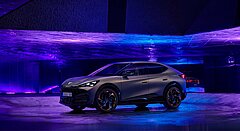
6. Hyundai IONIQ 7
If you’re looking for something special, this is the one. The IONIQ 7, measuring around 5.30 metres in length, marks the third Hyundai sub-brand model after the IONIQ 5 (crossover) and IONIQ 6 (sedan). Being based on Hyundai's E-GMP platform, it inherits the 800-volt charging technology from the IONIQ 6. The battery is placed under the vehicle between the axles, aiming for nearly 500 kilometres of range.
Do you want to allow Integration of youtube videos?
Allows the playback of videos, that are hosted on youtube.com. By allowing this feature, you accept the privacy agreement of google.
The Swivelling Lounge Chairs and LED light ring encircling the rear window are just some of the exciting features of the new IONIQ . On a long journey, you don't have to look for a place to take a break if, for instance, the weather is nasty outside or you find yourself in the middle of a forest. Simply swivel the seat into a comfortable position and enjoy the panoramic view out the window, which should be particularly enchanting when it's snowing or raining. #
The IONIQ 7 is larger than the IONIQ 6 or 5, and so is its battery.
Limited information is available about the charging characteristics of the vehicle. The IONIQ 7 is expected to charge as fast as the IONIQ 6, which counts to the fastest charging cars in 2023. We hold our breath and wait until Hyundai reveals its secrets. The electric car is expected to hit the market in late 2023 or early 2024.
-
Range: Up to 483 km
-
Top speed: No information available
-
Max DC charging power: 350 kW
-
Max AC charging power: No information available
-
Acceleration (from 0 to 100 km/h in sec): No information available
-
Battery capacity: 99,8 kWh
-
Consumption (kWh/100 km): No information available
-
Estimated price: From € 55,000
7. Peugeot E-3008
In February 2024, Peugeot is set to launch the E-3008, the first Stellantis model based on the STLA Medium platform. The top-range model has an impressive up to 700 km range, thanks to a new 98 kWh battery and an efficient 170 kW front-wheel drive system.
Additionally, there are two models with smaller batteries and less range: a 157 kW front-wheel drive and a 240 kW all-wheel drive variant. The 3008's streamlined design greatly benefits from optimised aerodynamics. The redesigned headlights are standard LED, with pixel LED technology in the GT version.
-
Range: Up to 524 km
-
Top speed: 180 km/h
-
Max DC charging power: 160 kW
-
Max AC charging power: 11 kW
-
Acceleration (from 0 to 100 km/h in sec): 6,4 s
-
Battery capacity: 73 kWh
-
Consumption (kWh/100 km): 14 kWh/100 km
-
Estimated price: € 52.000
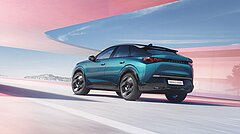
8. Ford Explorer
You might know the Ford Explorer as a hybrid car, but we are talking about a completely different, fully electric model. Its peak charging power of 170 kW allows the new Ford Explorer to charge from 10% to 80% in just 25 minutes with a fast DC charger. However, if you want to take better care of your car battery, it is best to avoid constant DC charging. Opting for a home wallbox that facilitates gentle AC charging is a wise choice for long-term battery health. Consider investing in one of the go-e Chargers for this purpose. Notably, the go-e Charger Gemini flex was recognized as the top performer in the Auto Bild and P3 Wallbox Test, offering exceptional value for money.
Do you want to allow Integration of youtube videos?
Allows the playback of videos, that are hosted on youtube.com. By allowing this feature, you accept the privacy agreement of google.
The 450 litres of trunk space in the Ford Explorer will make your travels super comfortable. Just pack as many things as you need for your journey and hit the road. For added comfort, the Explorer features massage seats and various connectivity services.
-
Range: Up to 500 km
-
Top speed: 180 km/h
-
Max DC charging power: 170 kW
-
Max AC charging power: 11 kW
-
Acceleration (from 0 to 100 km/h in sec): < 6 s
-
Battery capacity: 58 kWh or 77 kWh
-
Consumption (kWh/100 km): Noch keine Informationen verfügbar
-
Estimated price: €86.490 € - €87.490

9. BMW iX2
Let’s continue with German brands. Following its iX1 model, BMW is launching the iX2, an electric version of the X2 crossover, available in March 2024. It packs a 64.8 kWh battery under the vehicle floor, providing an estimated 449 km of range per the WLTP standard. With a peak charging output of 130 kW, at high-power DC charging stations, you can go from 10% to 80% charged in roughly 30 minutes. For comparison, the Hyundai IONIQ 6 with its range of more than 500 km, one of the fastest-charging electric vehicles, goes from 10 to 80% at a 350 kW DC charging point in 18 minutes.
The seats in the BMW iX2 come with standard fabric covering, while options like leather, sports seats, electric seat adjustment with memory function, and a massage feature are available for an extra cost. The panoramic glass roof makes the cabin feel more roomy as a lot of light comes in.
-
Range: Up to 449 km
-
Top speed: 180 km/h
-
Max DC charging power: 230 kW
-
Max AC charging power: 11 kW
-
Acceleration (from 0 to 100 km/h in sec): 5.6 s
-
Battery capacity: 64,8 kWh
-
Consumption (kWh/100 km): 16,3–17,8 kWh
-
Estimated price: From € 57.400

10. Mercedes EQG
Mercedes pledges practical daily ranges for the electric version of the timeless off-road vehicle, which has been in production since 1979. Emmerich Schiller, Head of Mercedes-Benz G GmbH, assures that the EQG off-road properties will be “at least as good as a combustion engine” if the charging infrastructure develops further. Notably, the electric drivetrain grants the off-road veteran a unique capability – the ability to pivot in place on its axis, similar to a tracked vehicle, thanks to the motors' reverse control.
-
Range: 483 km
-
Top speed: > 200 km/h
-
Max DC charging power: No information available
-
Max AC charging power: No information available
-
Acceleration (from 0 to 100 km/h in sec): 4,5 s
-
Battery capacity: No information available
-
Consumption (kWh/100 km): No information available
-
Estimated price: € 200.000

11. Renault Scenic E-Tech Electric
The Renault Scenic E-Tech Electric comes with up to 420 km range. The spacious design and 545 l trunk volume make the Scenic E-Tech Electric ideal for extended holiday and weekend trips. This French electric car measures 4.47m in length, 1.86 m in width, and 1.57 m in height, surpassing the 4.20 m long Megane E-Tech.
If you're wondering whether the production of electric cars is sustainable enough, you'll probably like the fact that the new Renault model is made from 90% recycled materials. Mark your calendar for spring 2024, that’s when the Scenic E-Tech Electric will be ready to hit the streets.
And for now, let’s see what the basic model offers.
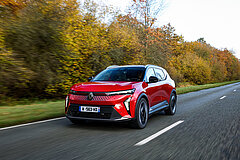
12. Citroen e-C3
The C3 is Citroën's most popular model, so it's no surprise that they decided to electrify it. The new Citroen e-C3 is a vehicle powered by a 44 kWh lithium iron phosphate battery. This battery type offers enhanced thermal and chemical stability, enduring more charging cycles than conventional lithium-ion batteries. It takes 26 minutes to charge the car from 10 to 80% when it is DC charging at its peak power of 100 kW.
The compact Citroën with its "Advanced Comfort" seats, claims a range of 320 km, meaning it’s a solid option for city use and commuting. This electric vehicle is expected to hit the market in spring 2024.
-
Range: Up to 320 km
-
Top speed: No information available
-
Max DC charging power: 100 kW
-
Max AC charging power: 11 kW
-
Acceleration (from 0 to 100 km/h in sec): No information available
-
Battery capacity: 44 kWh
-
Consumption (kWh/100 km): No information available
-
Estimated price: € 23,000
![[Translate to Englisch:] Citroen e-C3](/fileadmin/_processed_/c/6/csm_citroen-e-c3-driving_5e5b5d3c6f.jpg)
E-Mobility Trends 2024
Trend #1: Long range is the new normal
Long-range vehicles are becoming increasingly common in the automotive industry. Not so long ago, the Tesla Model S was considered outstanding with its range of 600 kilometres. In the coming year, however, vehicles such as the Renault Scenic E-Tech Electric and the Volvo EX90 are expected to match or exceed this range, which will come as no big surprise to anyone.
In any case, in order to enjoy long journeys and relaxed driving, it’s a good idea to fully charge your car battery before leaving home. That's exactly what you can do if you have your own smart wallbox like the go-e Charger. You can even set how many kWh should be charged and during which time in the go-e Charger app. Try it out!
Trend #2: More electric cars with bidirectional charging capabilities
Car manufacturers are increasingly equipping new e-vehicle models with bidirectional charging capability, which enables them to both draw power from the grid and send excess energy to the grid, turning them into powerhouses on wheels.
This development is important for two reasons:
- Firstly, it increases the dynamism and resilience of the power system to a level that could make even Nikola Tesla crack a smile. V2G-enabled electric vehicles can discharge stored energy during demand peaks, stabilising the grid and reducing the load on the electricity infrastructure. On a basic level, your car will be able to light up the night during power outages, making sure your movie night does not get interrupted.
- Secondly, it offers potential cost savings for EV owners. By selling surplus electricity to the grid, owners can offset their charging costs or even generate revenue.
Some electric cars on the market currently already support bidirectional charging, but without the right software or affordable charging stations for private households, their potential unfortunately remains largely untapped. Until the technology is finally ready for the market, there are simpler, faster and, above all, more cost-effective solutions, such as the go-e Charger, which offers numerous practical benefits with its smart features such as dynamic load management and flexible electricity tariffs, for example:
- A reliable, stable power supply
- Cost efficiency
- Stabilisation of the grid
- Increased convenience
Trend #3: Middle- and upper-class electric vehicles are becoming cheaper than ICE cars
According to ADAC, electric cars can be cheaper than petrol or diesel vehicles if you take into account the state subsidy and fuel consumption. But this money-saving advantage mainly applies to people who can afford mid-priced or more expensive cars. Small and very small cars still cost much more than electric cars. For example, a normal Opel Corsa costs €18,280 according to the price tag, but the electric version costs €36,395. The main reason for this large price difference is the high cost of the electric car's battery, which accounts for a larger proportion of the total cost in cheaper cars.